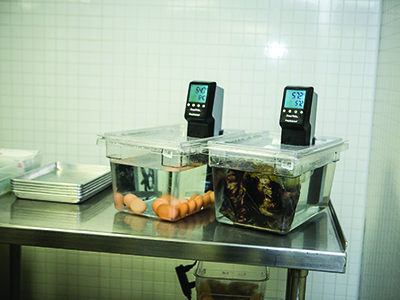Sous vide—cooking under vacuum—may be the “hottest” technique to hit restaurants, but it demands prep and food safety skills which are lacking in most kitchen staff.

Sous vide basics
The basic components of sous vide cooking are the vacuum sealer, bags or pouches, water bath and immersion circulator. Proper safety and food handling procedures are essential at each step.
The vacuum sealer removes air from the bag and seals it. Bags must be uncreased and free of contaminants. To create an oxygen-reduced environment, the seal must be tight around the food and fused completely across the seam.
The immersion circulator and water bath work together to cook the pouched food. The circulator moves water around the bag and its thermostat ensures a consistent, precise temperature. Bags should not be placed in water until it has reached temperature, and they must be totally submerged. Any bag that inflates or rises to the surface may be compromised. Cooking temperatures and times must be followed exactly per manufacturer’s instructions; internal temperature of food should be checked before serving.
Training for safety
Kendall College in Chicago recently started a dual education program on sous vide technique and equipment. One part is hands-on training for culinary students; the other is online education for chefs already in the field.
It’s critical for anyone working with sous vide to know “how to handle the ingredients properly, how to process and finish [the food] properly so that you have quality food,” says Renee Zonka, Dean of Kendall’s School of Culinary Arts. Bruno Bertin, executive chef for sous vide food producer Cuisine Solutions, agrees. “With sous vide you enhance the flavor,” he says, “but you can also enhance the bacteria.”
Proper food handling for sous vide cooking requires strict attention to food safety and establishment of a HACCP plan. Many health departments don’t allow the use of sous vide “because it’s reduced-oxygen packaging, which has some food dangers associated with it,” says Zonka. They want assurance that the food being served is safe; just a tenth of a degree can make a difference.
Back to school
To train tomorrow’s chefs, the college established a 1,300 square-foot kitchen dedicated to sous vide. The kitchen includes a range of sous vide equipment, a grill for pre-searing and a combi oven to finish the food. Students learn sous vide and HACCP procedures as part of the Modern Cuisine course.
For chefs already in the business, Kendall runs an online training program in partnership with CREA, the educational arm of Cuisine Solutions. The self-paced courses allow for give-and-take via a bulletin board system. The introductory course covers fundamentals of sous vide, including necessary HACCP procedures. At the end of the course, students take two final exams, one for sous vide certification and one on HACCP. Chefs who complete the training are then eligible to come to Kendall for a hands-on workshop
Members help make our journalism possible. Become a Restaurant Business member today and unlock exclusive benefits, including unlimited access to all of our content. Sign up here.